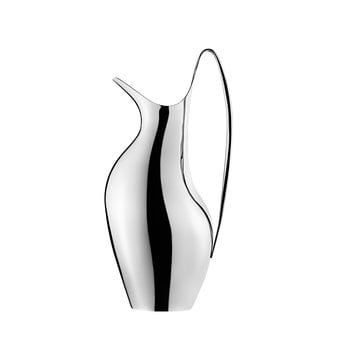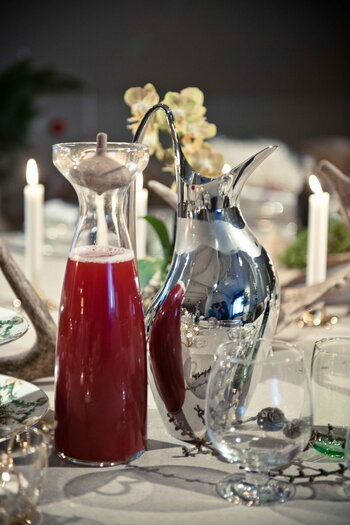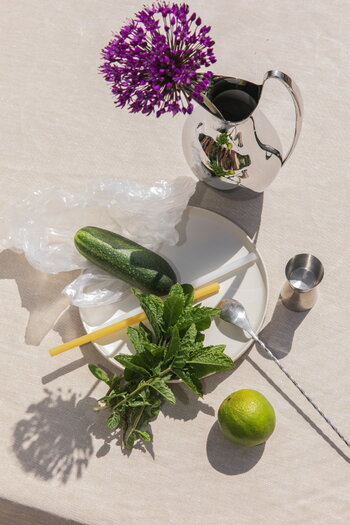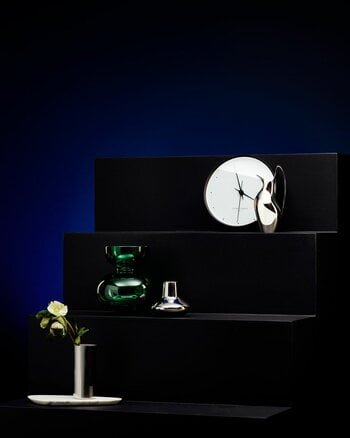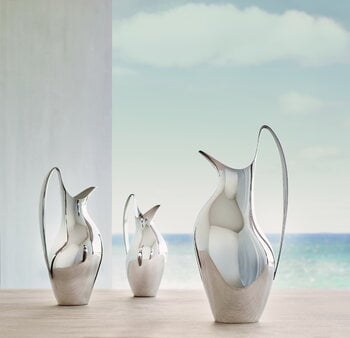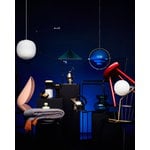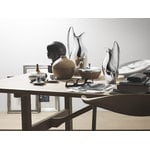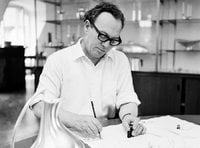Of all the designers to work with Georg Jensen through the years, Henning Koppel was among the most highly regarded. His designs played an important role in influencing the signature look of Georg Jensen, particularly in the second half of the 20th century. The designer had trained as a sculptor before turning his attention to jewelry, hollowware and cutlery. The silver pitcher is one of his most famous pieces and was first formed in 1952. It is spare but sensuous, with an elegantly extended handle and exaggerated lip. Georg Jensen began as a silversmith; this collection is a modern interpretation of the legacy of excellent craftsmanship that dates from the very beginning.
HK pitcher, 0,75 L
Georg Jensen
Description
Of all the designers to work with Georg Jensen through the years, Henning Koppel was among the most highly regarded. His designs played an important role in influencing the signature look of Georg Jensen, particularly in the second half of the 20th century. The designer had trained as a sculptor before turning his attention to jewelry, hollowware and cutlery. The silver pitcher is one of his most famous pieces and was first formed in 1952. It is spare but sensuous, with an elegantly extended handle and exaggerated lip. Georg Jensen began as a silversmith; this collection is a modern interpretation of the legacy of excellent craftsmanship that dates from the very beginning.
Product details (3)
- Material
- Mirror polished stainless steel
- Height
- 9.76 in (24.8 cm)
- Capacity
- 0.79 qt (0.75 l)
- Product ID
Designer
Henning Koppel (1918-1981) was a Danish designer and well-known as an earlier pioneer of functionalism in design. He studied drawing and aquarelle, and later on concentrated on sculpture at the Royal Danish Academy and then in Paris. Koppel came from a Jewish family and like many Danish Jews lived in Sweden during the Second World War.
While there he designed for Orrefors Glassworks, internationally renowned for their unique glass articles, art glass and household glass. When he went back to Denmark, Koppel began working at Georg Jensen, which marked his start in jewelry, hollowware and flatware design. His first works – a series of necklaces and bracelets resembling whale vertebrae and microscopic organisms – were small masterpieces in imaginative modeling. Henning Koppel was in every way groundbreaking and his jewelry was unlike anything ever created at the silver smithy in its first 40 years. During his carrier, Henning Koppel created an astonishing range of work: from stainless steel cutlery to magnificent one-off signature pieces such as the silver and crystal chandelier he designed to celebrate the 75-year anniversary of Georg Jensen in 1979. The HK pitcher and Caravel cutlery are among the most famous pieces he designed for Georg Jensen. Elegant and functional, both the pitcher and Caravel cutlery were originally produced in sterling silver, but are nowadays manufactured from stainless steel. Koppel designed also clocks and lighting for Louis Poulsen and postage stamps for the Danish Post Office. During his life, he won many awards including three Gold Medals at the Milan Triennial, the International Design Award of the American Institute of Designers and the Lunning Prize. Koppel’s works are represented in numerous museums worldwide.
View all productsReviews (1)
5
Based on 1 reviews
-
Y
Yangzi L
Singapore
180 days ago
Sustainability
The Product Sustainability Framework, our criteria of sustainable design, helps you find the most sustainable products in our selection. Read below which sustainability criteria this product has met.
Working conditions & labour 9/9
-
Equal opportunities for all employees
-
Commitment to UN Global Compact, fair compensation for all employees
-
Corporate responsibility requirements defined and communicated for suppliers
-
Systematic work for improved inclusion and well-being in the workplace
-
Transparent supply chain
-
Suppliers' compliance to a code of conduct ensured
-
Direct suppliers audited and certified
-
Compliance to the UN Guiding Principles on Business and Human Rights ensured in the supply chain
-
Support for community involvement in the supply chain
Eco-friendly production 6/9
-
Fair and resource-wise water-use in production
-
No incineration or landfilling of returned items
-
No use of endangered species as materials
-
No direct environmental emissions or waste (excl. GHGs) from production
-
Material-efficient and ecological packaging
-
No potentially harmful chemicals used in own production
-
The sustainability of direct suppliers' production is addressed and monitored
-
Production and material sourcing that respect biodiversity, animal rights, and natural ecosystems
-
Positive impact on nature’s well-being through operations that regenerate natural ecosystems
Climate impact 4/8
-
Company's direct greenhouse gas emissions identified and commitment to reduction
-
Product's carbon impact identified and commitment to reduction
-
Guidance on energy- and eco-efficient use of the product
-
Contribution to climate initiatives beyond the brand’s direct operations
-
Low-carbon or compensated transportation
-
Carbon footprint of the product calculated and goals set to reduce it
-
100 % renewable energy in own production and operations
-
Carbon neutral or carbon negative product
Sustainable materials 5/6
-
Sustainable and long-lasting material choices
-
No harmful or hazardous substances
-
Responsible raw material sourcing and production
-
Materials suited for circularity: monomaterials, recyclable finishings, renewable or recycled contents etc.
-
Ecological materials: natural, biodegradable, recyclable or recycled contents
-
Outstanding materials in terms of innovativeness, responsibility, sustainability and circularity: local production or sourcing, 100 % recycled content, C2C-certification etc.
Circular design 4/5
-
High aesthetic quality promoting long-term use of the product
-
Technically durable product design and material choices
-
Design for enduring life-long quality
-
Design and support for product maintenance, repair and upgradability
-
Innovative circular design solutions: circular service system, resale platform, remanufacturing, collection of used products, etc.
